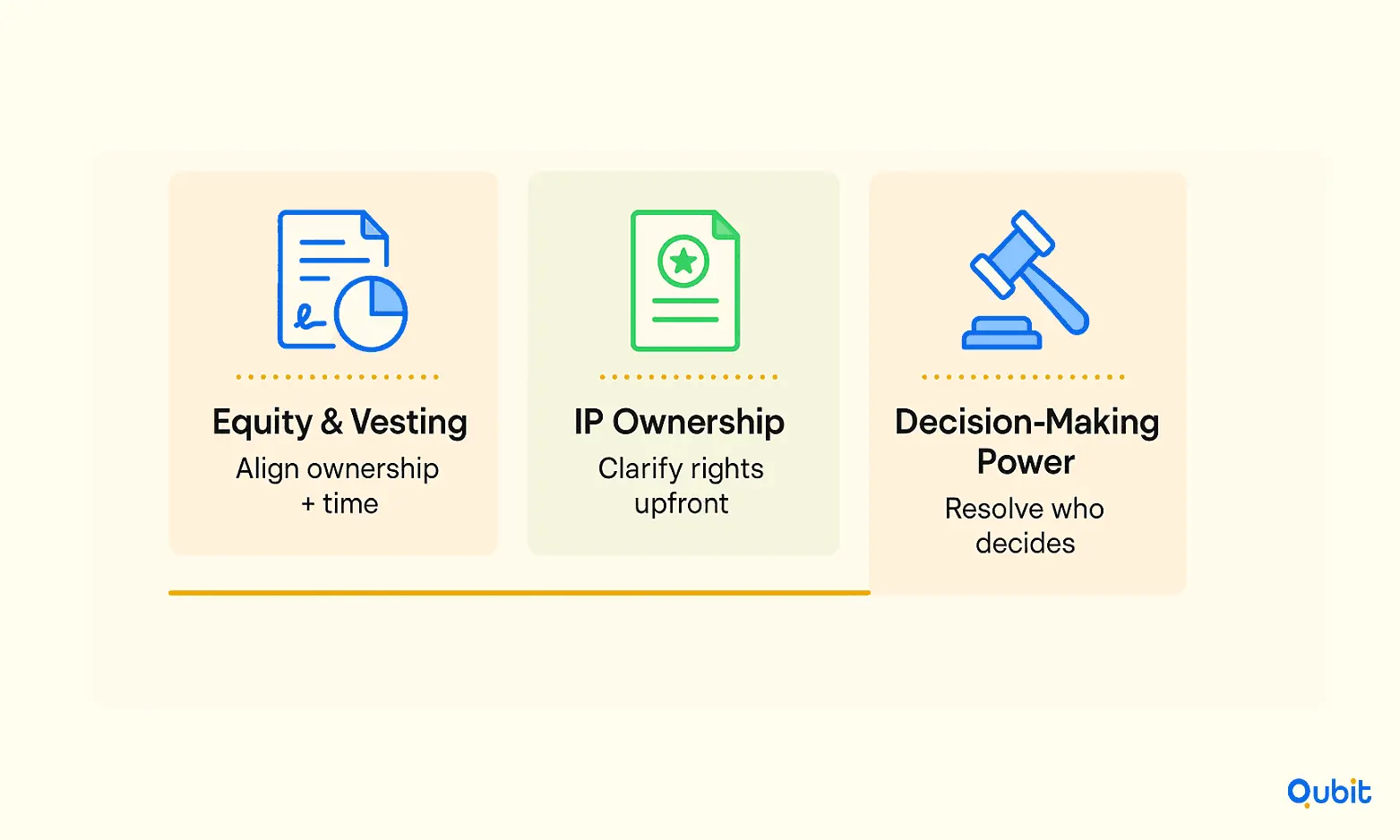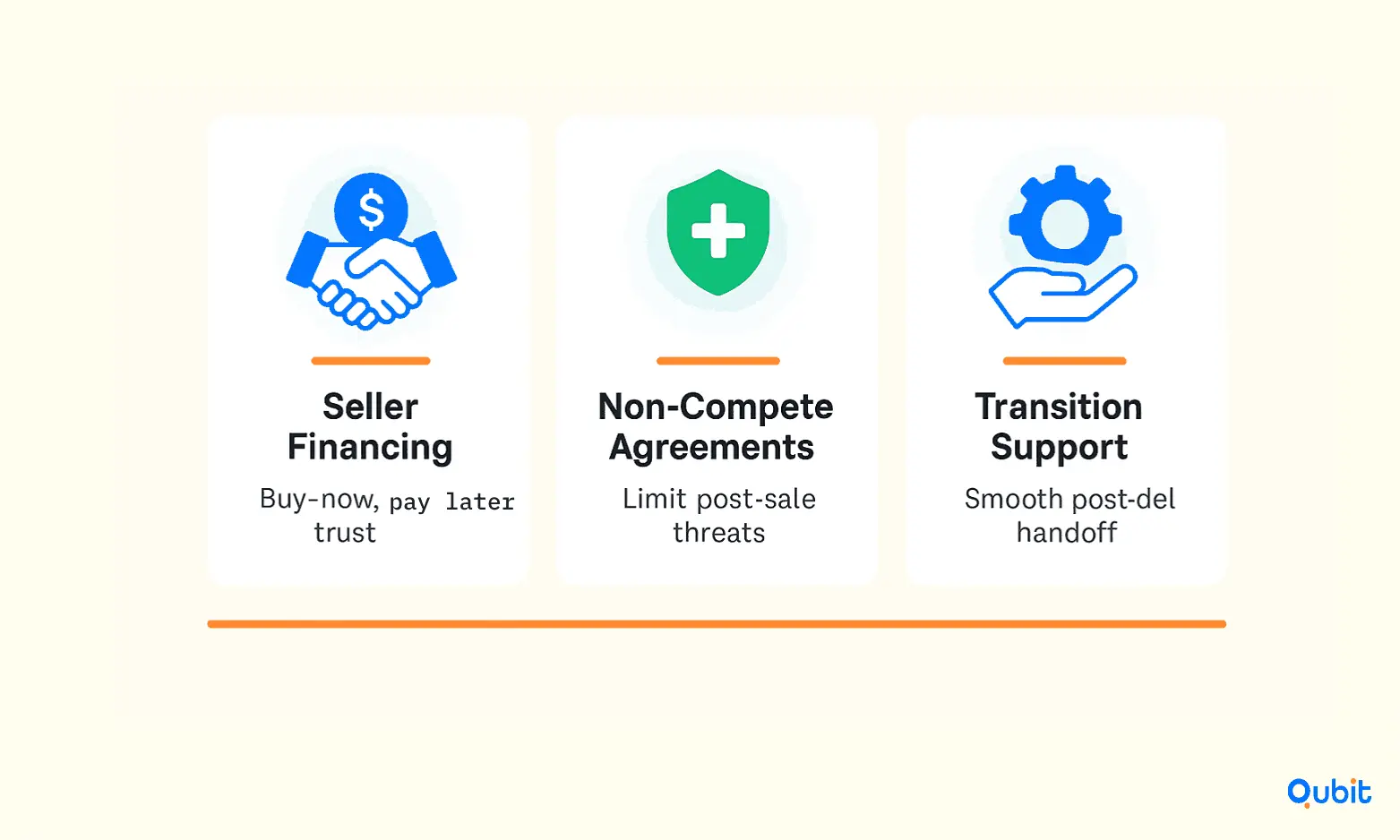Mergers and acquisitions (M&A) often resemble assembling a puzzle, where each piece represents a critical element of the deal. The process demands collaboration, much like the image illustrating business people holding jigsaw pieces and merging them together. This visual metaphor underscores the importance of teamwork in aligning equity structures and strategic goals.
Understanding how investors approach evaluating startups for acquisition during fundraising is essential to grasp the financial and operational metrics that influence decision-making. A discussion on evaluating startups for acquisition during fundraising advances your grasp of how financial metrics influence target selection.
This blog explores how investor alignment on equity structures, proper vesting, and innovative deal designs can lead to more successful startup acquisitions. Let’s dive into the key strategies that make these transactions impactful.
Setting Expectations Between Founders
Establishing clear expectations among founders is crucial for building a strong foundation for any business. Early alignment on roles, responsibilities, and ownership distribution ensures that everyone is on the same page, reducing potential conflicts down the road.

Key areas to address include equity distribution, vesting schedules, intellectual property ownership, and decision-making authority. For instance, founders should agree on how equity will be divided and whether it will vest over time to incentivize long-term commitment. Similarly, clarifying who owns the rights to intellectual property created during the startup phase can prevent disputes later. Decision-making processes, such as who has the final say in critical matters, should also be defined to avoid ambiguity.
Experts emphasize that when founders align on these critical topics early, it not only strengthens their partnership but also simplifies deal structuring with investors or stakeholders in the future. Clear agreements create a roadmap for smoother operations and help the business remain focused on growth rather than internal disagreements.
Taking the time to set these expectations upfront is an investment in the company’s long-term success. It ensures that all founders are working toward shared goals with a mutual understanding of their roles and contributions.
Vesting and Founder Commitments
Vesting schedules play a pivotal role in ensuring the long-term stability of startups. By structuring equity distribution over time, they encourage founders to remain committed to the company’s growth while safeguarding against the risks of abrupt departures. This approach not only protects the startup’s operational continuity but also reassures investors and stakeholders about the team’s dedication.
A standard vesting period typically spans four years, with a one-year cliff. This means that no equity is vested during the first year, but after 12 months, a significant portion is granted, followed by incremental vesting over the remaining term. Such arrangements are widely used in term sheets to align founder incentives with the company’s long-term success.
Industry data highlights that startups with disciplined vesting structures are better positioned during acquisition negotiations. These schedules provide clarity on equity ownership, reducing potential conflicts and ensuring smoother transitions. For founders, this structure fosters a sense of shared responsibility, as equity is earned through continued contribution rather than upfront allocation.
By implementing a well-defined vesting schedule, startups can create a foundation of trust and commitment, ensuring that all stakeholders are aligned toward achieving sustainable growth and success.
Equity Splits With Early Employees
Allocating equity to early employees is a pivotal strategy for startups aiming to attract top-tier talent. Employee stock option pools serve as a designated reserve of company equity, specifically created for early hires. This approach ensures that employees feel invested in the company’s success while safeguarding founder ownership from excessive dilution.
Proper planning of equity splits is essential to align with long-term company objectives. By carefully structuring the allocation, founders can maintain control while offering meaningful incentives to early team members. Discussing how an Employee Stock Option Pool helps attract key talent without overly diluting founder stakes highlights the importance of strategic equity management.
For startups, equity allocation is more than just a financial decision, it’s a tool for fostering commitment and collaboration. Early employees often play a critical role in shaping the company’s trajectory, and equity rewards their contributions while encouraging alignment with the company’s vision.
Bringing Investors Into the Structure
Structuring equity to meet investor expectations is a critical step for startups seeking funding. Investor equity agreements frequently include provisions like preferred stock rights, liquidation preferences, and anti-dilution protections. These elements not only safeguard investor interests but also enhance their confidence in the venture.
Preferred stock often comes with rights that prioritize investors during liquidation events. For instance, liquidation preferences ensure that investors recover their investment before common shareholders in the event of a sale or dissolution. Anti-dilution provisions, on the other hand, protect investors from equity dilution during future funding rounds, maintaining the value of their stake.
The term sheet plays a pivotal role in this process. As a preliminary document, it outlines the basic investment terms and clarifies investor preferences, setting the groundwork for final negotiations. Once agreed upon, these terms are formalized in binding equity agreements that define ownership and rights.
Understanding how fundraising affects startup acquisition is also essential, as it illustrates the interplay between funding choices and future deal dynamics. This segment highlights how strategic equity structuring can shape acquisition outcomes.
By integrating these investor-focused provisions, startups can create a robust equity structure that aligns with both their growth goals and investor expectations.
Designing Simple and Scalable Equity Structures
Crafting equity agreements that are both straightforward and adaptable is crucial for early-stage companies. Clear structures not only simplify ownership distribution but also ensure flexibility to accommodate future growth and evolving market conditions.
Overly complex equity arrangements can create unnecessary hurdles, deterring potential investors and complicating adjustments during funding rounds. Instead, focusing on simplicity allows businesses to pivot quickly and maintain transparency. For example, referencing a Cap Table is an effective way to track ownership distribution and illustrate how founder and investor shares evolve across funding rounds. This tool supports scalable growth by providing a clear snapshot of equity allocation.
Best practices for equity design emphasize adaptability. Agreements should be structured to accommodate changes in market dynamics, ensuring that businesses remain agile as they scale. By prioritizing clarity and scalability, companies can foster investor confidence and streamline decision-making processes.
Early-stage businesses thrive when equity structures are designed with growth in mind. Keeping agreements simple not only reduces administrative burdens but also positions the company for long-term success in competitive markets.
Navigating Tax and Regulatory Challenges
Equity agreements often come with significant tax implications, making compliance a critical priority for founders and startups. One essential consideration is the Section 83(b) Election, which allows founders to pay taxes on restricted stock at the time of grant rather than when it vests. This proactive approach can save substantial tax liabilities in the future. However, timing is crucial, founders must file the election within 30 days of the stock grant to avoid unintended tax consequences.
Beyond tax considerations, startups must also adhere to state and federal regulations to ensure their equity agreements are legally sound. Regulatory scrutiny has grown more stringent, influencing deal timelines and structures. Failing to meet compliance standards can lead to delays, penalties, or even jeopardize the agreement altogether.
By addressing both tax and regulatory challenges early, startups can safeguard their equity agreements and avoid costly mistakes. For founders, understanding these complexities is not just about compliance—it’s about setting the foundation for sustainable growth.
Preparing for Future Funding Rounds
Structuring equity agreements with foresight can significantly impact a company's ability to attract future investors. Early-stage agreements should be designed to accommodate the complexities of subsequent funding rounds, ensuring that ownership and decision-making remain balanced as new stakeholders come on board.
Incorporating provisions like pro-rata rights is a strategic move. These rights allow existing investors to maintain their ownership percentage during future funding rounds, preventing dilution and fostering long-term trust. Similarly, drag-along rights can streamline exit opportunities by ensuring minority shareholders comply with decisions made by the majority, reducing potential conflicts during acquisitions or sales.
Planning for future funding rounds also means anticipating the needs of both current and future stakeholders. By building flexibility into initial agreements, businesses can avoid disruptive renegotiations and maintain momentum as they scale. This proactive approach not only simplifies transitions but also signals to potential investors that the company is prepared for sustainable growth.
Avoiding Common Pitfalls in Acquisition Deals
Acquisition deals can be complex, and even minor missteps can lead to significant financial and operational setbacks. One common mistake is allocating too much equity early in the process. Overcommitting equity can dilute ownership and reduce flexibility for future negotiations or funding rounds. To avoid this, treat equity agreements as living documents that require regular review and adjustment to align with evolving business needs.
Another frequent oversight is ignoring the tax implications of the deal structure. Tax consequences can significantly impact the financial outcome for both parties. Consulting with tax professionals early in the process ensures that the deal is structured in a way that minimizes liabilities and maximizes benefits.
Additionally, failing to adapt to changing market conditions can expose the deal to unnecessary risks. Continuous review of the acquisition terms allows for adjustments that reflect current market realities. For instance, ensuring proper valuation is critical, as overpaying can jeopardize the financial health of the acquiring company. An exploration of avoiding overvaluation in acquisitions introduces measured approaches that align pricing models with realistic market conditions.
By addressing these common pitfalls proactively, businesses can secure more favorable outcomes and build a stronger foundation for long-term success.
Ensuring Clarity Through Thorough Documentation
Clear and accurate documentation is the backbone of a successful acquisition process. Maintaining meticulous records of equity issuances ensures compliance with legal requirements and fosters trust among investors. When every detail is accounted for, stakeholders gain confidence in the transparency and reliability of the company’s operations.
Cap tables, which outline ownership structures, play a pivotal role in this process. These tables, along with their supporting documents, should be updated regularly to reflect any changes in equity distribution. Secure storage of these records is equally important, as it safeguards sensitive information and ensures easy access when needed.
Thorough documentation not only supports regulatory compliance but also demonstrates a commitment to operational integrity. This level of diligence can significantly enhance investor confidence, especially during critical moments like acquisitions or funding rounds. By prioritizing clarity and organization, businesses position themselves as trustworthy and well-prepared partners in the eyes of potential investors.
Regularly Revising Deal Agreements
Business landscapes evolve rapidly, and equity agreements must keep pace. Periodic reviews of these agreements are essential to ensure they align with the company’s current objectives and the expectations of stakeholders. As businesses grow, factors such as market conditions, operational priorities, and team dynamics can shift, making it critical to revisit the terms of equity distribution.
Clear communication during these revisions fosters trust and transparency among all parties involved. Documenting updates not only ensures legal compliance but also minimizes the risk of misunderstandings. This proactive approach helps maintain a harmonious relationship between stakeholders while safeguarding the company’s long-term interests.
Regularly revising equity agreements isn’t just about addressing immediate changes; it’s about preparing for the future. By staying adaptable and responsive to evolving circumstances, businesses can create a foundation that supports sustainable growth and mutual success.
Decoding Merger & Acquisition Deal Structures
Structuring a merger or acquisition deal requires a nuanced understanding of the options available and the challenges they present. From asset purchases to stock acquisitions, each structure offers distinct advantages and potential hurdles. Asset purchases, for instance, allow buyers to cherry-pick specific assets while avoiding liabilities, but they can be complex due to the need for individual asset transfers. On the other hand, stock acquisitions provide a more straightforward path to ownership but often include inheriting the seller’s liabilities.
Hybrid deal structures are gaining traction as businesses seek to address valuation gaps and mitigate uncertainties in volatile markets. Earnouts, for example, tie part of the purchase price to the future performance of the acquired company, aligning interests and reducing immediate financial risk. Similarly, contingent value rights (CVRs) offer a mechanism to bridge differing valuations by linking payments to specific milestones.
The rise of innovative deal structures is evident in sectors like technology, where rapid growth and fluctuating valuations demand creative solutions. For example, the number of AI startup acquisitions surged by 53%, reaching 454 transactions, reflecting growing investor interest and the need for adaptable deal frameworks. Additionally, deal values in the first seven months of 2025 climbed to $55.3 billion, an 11% increase over 2024, signaling sustained momentum despite market volatility.
To deepen your understanding of the intricacies involved, an exploration of startup acquisition strategies broadens your perspective on structuring deals effectively. By mastering these approaches, businesses can better position themselves to capitalize on opportunities while managing risks.
Whether navigating regulatory complexities or addressing valuation disparities, selecting the right deal structure is pivotal for successful mergers and acquisitions.
Asset vs. Stock Purchases
When acquiring a business, buyers often face a critical decision: purchasing assets or acquiring stock. Each approach carries distinct implications for liabilities, taxation, and operational continuity.
Liability Considerations
Asset purchases allow buyers to select specific assets while avoiding most of the seller’s liabilities. This minimizes exposure to unforeseen debts or legal obligations. Conversely, stock purchases transfer ownership of the entire company, including its liabilities, making thorough due diligence essential.
Tax Implications
Tax treatment differs significantly between the two methods. Asset purchases often enable buyers to step up the tax basis of acquired assets, potentially reducing future tax burdens through depreciation. Stock purchases, however, do not offer this advantage, as the tax basis remains unchanged. Sellers, on the other hand, may prefer stock sales for favorable capital gains treatment.
Operational Continuity
Stock purchases ensure seamless operational continuity, as the business entity remains intact. Contracts, licenses, and customer relationships typically transfer without disruption. Asset purchases, however, may require renegotiation of agreements, which can complicate the transition process.
Understanding these differences is crucial for structuring acquisition deals effectively. Buyers must weigh their priorities carefully to choose the approach that aligns with their strategic goals.
Earn-Out Structures
Earn-out agreements offer a dynamic solution for bridging valuation gaps during business acquisitions. By tying a portion of the purchase price to the future performance of the acquired business, these agreements create a shared incentive for both buyers and sellers. This structure ensures that the seller benefits from the company’s continued success, while the buyer mitigates the risk of overpaying for an underperforming asset.
Typically, earn-outs are structured around specific performance metrics, such as revenue growth, profit margins, or customer retention rates. These metrics are agreed upon during negotiations and serve as benchmarks for determining additional payouts. For instance, if the acquired company meets or exceeds the agreed-upon targets, the seller receives the contingent payments as outlined in the agreement.
This approach not only aligns the interests of both parties but also fosters trust and collaboration during the transition period. However, earn-out agreements require careful drafting to avoid disputes. Clear terms, measurable metrics, and defined timelines are essential to ensure transparency and fairness.
Earn-outs are particularly valuable in industries with fluctuating market conditions or when the buyer and seller have differing views on the company’s future potential. By focusing on performance-based outcomes, these agreements create a win-win scenario for all stakeholders.
Supporting Deal Elements
Acquisition deals often include additional components that protect the interests of both parties. Seller financing, for instance, allows buyers to pay a portion of the purchase price over time, easing financial strain while demonstrating the seller’s confidence in the business’s future. This arrangement can foster trust and create a smoother transaction process.

Non-compete agreements are another critical element. These legally binding contracts prevent sellers from starting or joining competing ventures within a specified timeframe and geographic area. By ensuring the buyer’s investment is safeguarded from immediate competition, these agreements contribute to the stability and growth of the acquired business.
Transition support is equally vital. Sellers often provide hands-on assistance during the initial phase post-acquisition, offering insights into operations, customer relationships, and industry nuances. This collaborative approach ensures continuity and minimizes disruptions, helping buyers adapt more effectively.
Together, these supporting deal elements strengthen the foundation of acquisition agreements, addressing potential risks and fostering mutual confidence. Whether it’s financial flexibility, competitive protection, or operational guidance, these components play a pivotal role in achieving successful outcomes for both buyers and sellers.
Conclusion
Achieving long-term success in startup equity management requires a combination of strategic foresight and meticulous execution. Aligning founders' visions, implementing effective vesting schedules, and establishing clear equity splits are foundational steps. Additionally, exploring innovative M&A deal structures can open new avenues for growth. However, these strategies are only as effective as the documentation supporting them. Regular reviews and proactive adjustments ensure that agreements remain relevant and beneficial as the business evolves.
If you're ready to identify promising acquisition opportunities, we invite you to explore our Startup Matchmaking service for tailored solutions.
Key Takeaways
- Clear founder alignment and disciplined vesting schedules are critical to successful acquisitions.
- Optimized equity splits and scalable agreements attract and retain investor interest.
- Navigating tax and regulatory challenges, including timely Section 83(b) filings, prevents costly pitfalls.
- Understanding diverse M&A deal structures, from asset versus stock purchases to earn-outs, empowers better decision-making.
- Thorough documentation and regular agreement reviews ensure long-term clarity and strategic alignment.
Frequently asked Questions
What are the key components of a startup acquisition deal?
Key components include equity structuring, clear vesting schedules, appropriate investor rights, and supportive deal elements such as seller financing and non-compete terms.






